
With summer here and Jams coming up a topic that comes up a lot is "what shoes should I wear?". Well that is a very personal question really. Do they have a tight budget, do they like minimalist shoes and how long have they been training? All these questions have to be considered, and they have been many times. Luckily Zach Cohn wrote a list of parkour shoes that are viable options. And While he himself states it's "not exhaustive" he does a good job of getting plenty of shoes in there.
To get the full article read on.....
As parkour has grown in popularity, a lot of companies have created and sold parkour shoes. A lot of people ask me what is the best shoe for Parkour, so I’ve put together this guide to the most common shoes people might suggest for Parkour. This is by no means an exhaustive list, these are just the most common ones that I have enough experience with to review.
One quick note: I am a big fan of minimalist shoes. There’s a lot of research out there that shows that the more padding and cushioning a shoe has, the MORE damage it does to your feet, knees, and hips. That’s out of the scope of this article though.
Full disclosure: In early 2010 I received some free Ariakes from K-Swiss. This has not influenced my review, but I wanted to be transparent.
K-Swiss Ariake

K-Swiss Ariake Parkour Shoe
Around $100
Description:
This was the first shoe created and marketed specifically for Parkour. They’re made by K-Swiss. They sent a lot of free pairs out to traceurs a few years ago to help spread the word about being a Parkour shoe. Many people wearing Ariakes got theirs for free, either directly from K-Swiss or from someone who got them from K-Swiss. They also come in lots of different (and crazy) colors, which can be a pro or a con depending on your preference. :)
Pros:
- Pretty good grip on most surfaces in most conditions.
- Pretty flexible
- Flat, solid rubber sole. There’s no dumb plastic arch or anything like that.
Cons:
-Can be very slippery on wet metal objects (rails).
-Durability. The toe will rip open, and the lacing holes will start to rip. You can still wear the shoe, but it will sustain cosmetic and eventually structural damage fairly quickly.
Overall:
Definitely not a bad shoe. I like shoes with less padding, and while this shoe has some, it doesn’t have a ton. The quality is the biggest problem – the shoe will tear itself apart after 6-8 months of moderate use, 2-4 months of heavy use. The shoe is mostly leather, so it’s a nice shoe to wear to keep your feet slightly drier.
K-Swiss Ariake Lite Mesh

K-Swiss Ariake Lite Mesh Parkour Shoe
Around $110
Description:
The Ariake Lite Mesh came out about a year after the Ariake and solved many of the problems with the original shoe. It replaced a lot of the leather with mesh, which made the shoe lighter and breathier. They improved the durability by redesigning the toe and the lace holes so they don’t get damaged as easily.
Pros:
- All the pros from the original Ariakes
- Lighter
- Much more durable
Cons:
- Slippery when on wet metal objects.
- Since the shoe is mostly made of mesh, it will absorb water rapidly.
- Very difficult to find.
Overall:
The Ariake Lite Mesh is one of my favorite Parkour shoes. The biggest downside is that they’re very hard to find. K-Swiss doesn’t sell them directly anymore, so you’ll have to search elsewhere online or get really lucky in a store.
Fiveten Freerunner

Fiveten Freerunner Parkour Shoe
$90
Description:
I haven’t owned a pair of these shoes, and so I don’t have extensive personal experience with them. I’ve tried on other peoples’ a few times, and then read a fair bit about them.
Pros:
- The rubber is extremely grippy. 5.10 originally made climbing shoes, so this makes a lot of sense.
Cons:
- The rubber is extremely grippy. This is also a con, because this extra grippiness can and will hide problems with technique.
- When wearing them, I found them to be a bit clunky. I had a lot of trouble “feeling” the ground under my feet, which makes me very uncomfortable. The padding was just too thick.
Overall:
- I’m not a big fan of these shoes (which is why I don’t own a pair). I don’t like the fact the thickness of them, and I think the extreme grip is actually a detriment to someone learning parkour. If I was in a wallrun contest, then I’d wear these Parkour shoes, but if I’m just training I’d prefer something more normal.
Feiyue

Feiyue Parkour Shoe
$15
Description:
These are really interesting shoes. They weren’t created for Parkour or ever marketed toward traceurs. These are originally martial arts shoes, and are often found in China Towns and martial arts stores. They have a cloth top, a thin, extremely flexible, and pretty grippy bottom, and they have simple laces. The most outstanding part of this shoe is it’s price – between $10 and $20. They only last 3 or 4 months, but they cost a fraction of the price of any of the other speciality parkour shoes. Many people buy 5 pairs of Feiyue’s at a time!
Pros:
- Extremely inexpensive.
- Very flexible.
- Very lightweight.
- Very little padding.
Cons:
- You’ll wear through the bottoms of them pretty fast.
Overall:
I love these shoes. They’re comfortable, flexible, light, and extremely cheap. Buy a couple pairs and be set for a year.
Vibram Five Fingers

Vibram Five Finger Parkour Shoes
Around $75
Description:
I love these shoes. I don’t have a pair yet, but they’re going to be my next shoe purchase. The ultimate minimalist shoe, there is essentially no padding, pretty good grip on most surfaces, and forces you to have perfect technique (in running and walking as well as Parkour!)
Pros:
- Extremely minimal padding. Expect your landing technique to improve dramatically.
- As long as you get the right size, expect a very snug fit. They shouldn’t be going anywhere!
- Paying a premium actually makes sense for these foot-fitting shoes, as opposed to other shoes that are basically just shells for your feet.
- Will force you to improve landing and precision technique.
- Will improve running technique, which can prevent or fix some foot, ankle, knee, and hip problems.
Cons:
- Can be dangerous if you don’t take it slow. It’s imperative you avoid big drops and precisions, at least until you build back up to them.
- Very little protection if something gets dropped on your foot or if you stub your toe.
Overall:
The Vibram Five Fingers are really great Parkour shoes. Some people like to “go big” and do big drops – I discourage this because it leads to a higher rate of injuries. If you want to go big, these will not be good shoes for you. If you want to improve your technique, if you want to train and prevent long term injuries, these will be great shoes for you. You’ll pay around the same price as other high end shoes, but these are definitely worth it.
Conclusion
For the dedicated traceur with no budget, I’d recommend the Vibram Five Fingers. If you don’t want to spend that much, but still want a great minimalist shoe, I’d definitely look into (a few pairs of) the Feiyues. If you aren’t interested in a minimalist shoe, the Ariake Lite Mesh and then the regular Ariake would be my recommendation.
That being said, if you’re just getting into parkour, you should ignore everything in this article for a few months. Head over to a general clothing store, find a pair of cheap $35 cross trainers and use those for a while. Technique is 90% of Parkour, owning “the right shoes” is only going to get you a bit farther, and until then it’ll just mask problems with your technique.
Things to look for in a cheap crosstrainer:
- No plastic arch on the bottom.
- Bottom isn’t slick. If you have to, put your foot in the shoe and rub it against a few surfaces to get an idea of how grippy it is.
- Not too much padding or cushioning.
Now get out there and start training! :)
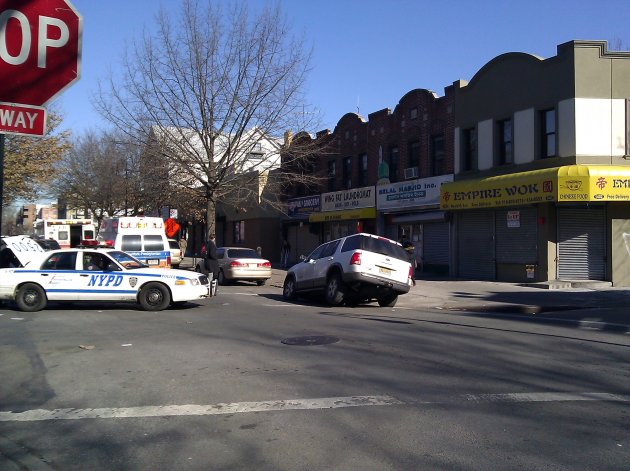 Sinkhole Swallows SUV
Sinkhole Swallows SUV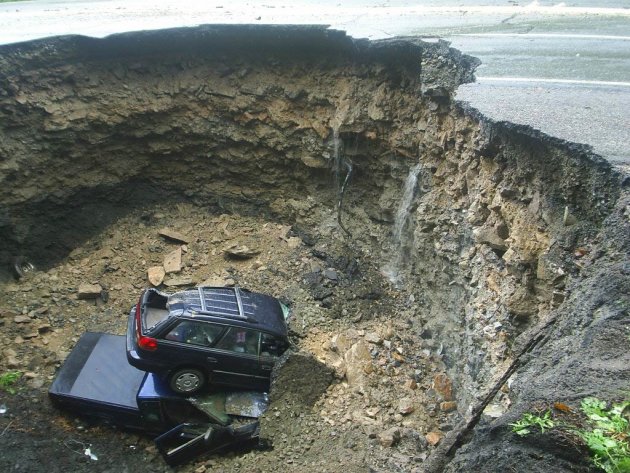
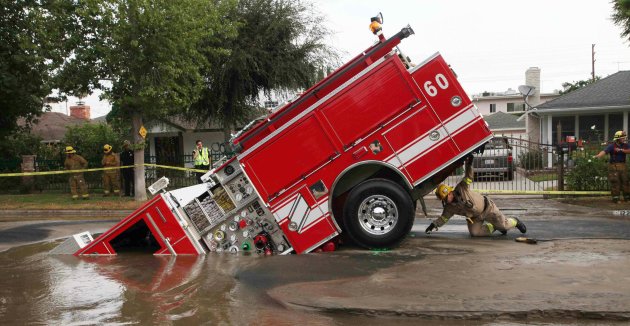 A Los Angeles fire engine topples over in a sinkhole caused by a burst water pipe.
A Los Angeles fire engine topples over in a sinkhole caused by a burst water pipe.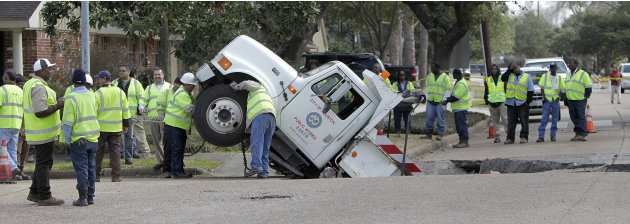 City crews work to attach chains on a City of Houston Public Works dump truck, after it fell into a sink hole caused by a cave-in on Balmforth at Dumfries near Godwin Park, Tuesday, Feb. 8, 2011, in Houston. Officials said the truck was carrying gravel to repair potholes on the street when the road fell out beneath the truck, which fell into the hole backwards. No injuries were reported and the truck was later lifted out by a large crane.
City crews work to attach chains on a City of Houston Public Works dump truck, after it fell into a sink hole caused by a cave-in on Balmforth at Dumfries near Godwin Park, Tuesday, Feb. 8, 2011, in Houston. Officials said the truck was carrying gravel to repair potholes on the street when the road fell out beneath the truck, which fell into the hole backwards. No injuries were reported and the truck was later lifted out by a large crane. 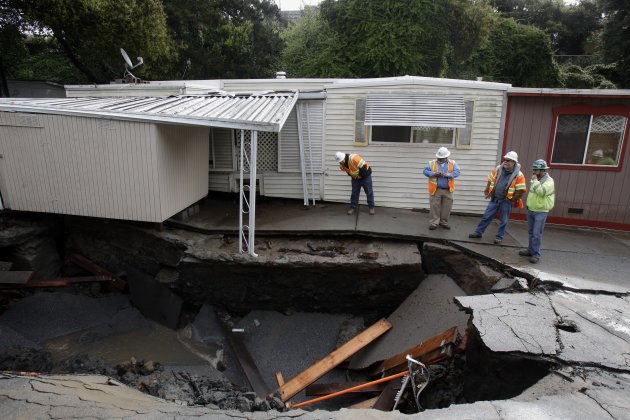 Workers inspect a sink hole caused by flooding at the Pacific Cove Mobile Home Park in Capitola, Calif., Friday, March 25, 2011. A powerful storm swept across California flooding part of Capitola, in Santa Cruz County, and forcing dozens of mobile homes residents to evacuate. The storm soaked hillsides along the coast threatening landslides as the rain continues.
Workers inspect a sink hole caused by flooding at the Pacific Cove Mobile Home Park in Capitola, Calif., Friday, March 25, 2011. A powerful storm swept across California flooding part of Capitola, in Santa Cruz County, and forcing dozens of mobile homes residents to evacuate. The storm soaked hillsides along the coast threatening landslides as the rain continues.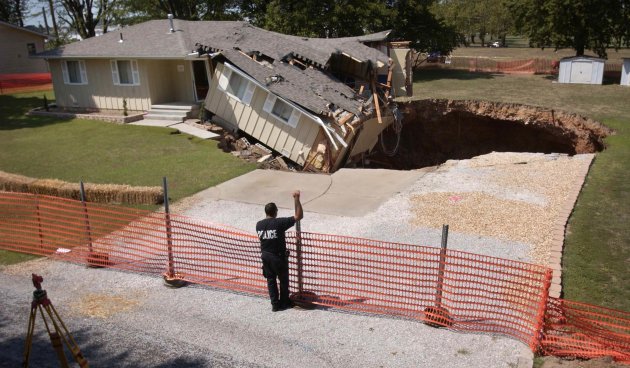 A sinkhole opens up in Nixa, Missouri.
A sinkhole opens up in Nixa, Missouri.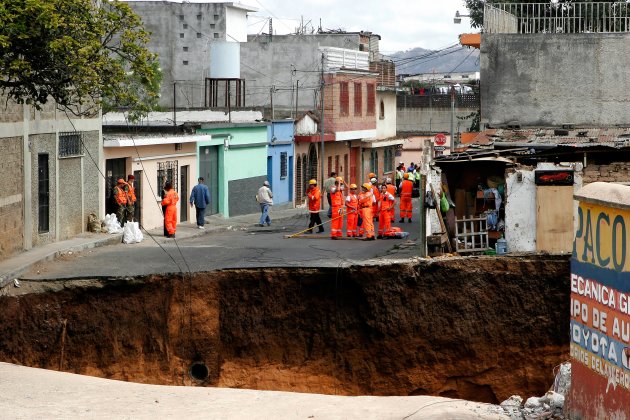 A structure is swallowed up after a sinkhole opened up in Guatemala City.
A structure is swallowed up after a sinkhole opened up in Guatemala City.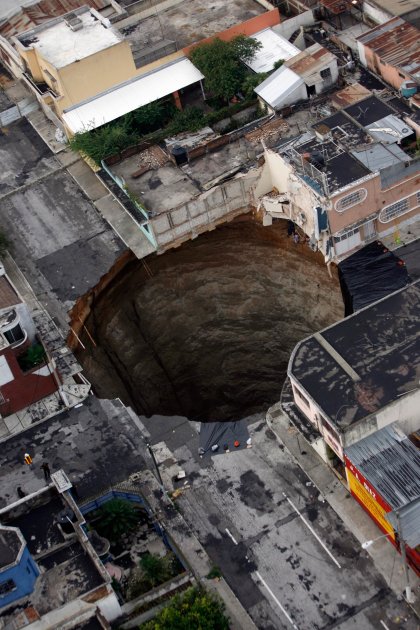 A bird's-eye view of the giant sinkhole which swallowed a 3-storey building after it opened up in Guatemela City last year.
A bird's-eye view of the giant sinkhole which swallowed a 3-storey building after it opened up in Guatemela City last year.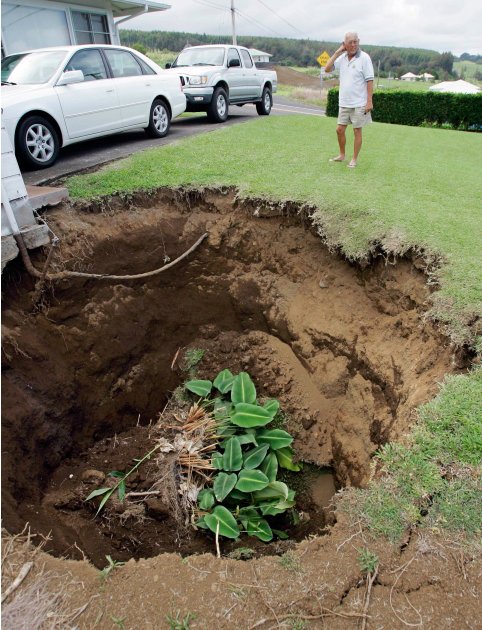 A homeowner looks at a sinkhole that appeared outside his Hawaii home after a 6.7 tremblor struck the island in 2006.
A homeowner looks at a sinkhole that appeared outside his Hawaii home after a 6.7 tremblor struck the island in 2006.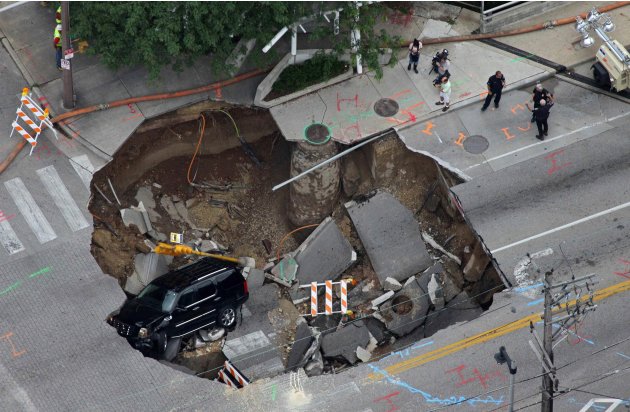 Powerful thunderstorms and widespread flooding caused this sinkhole to open up in Milwaukee, Wisconsin.
Powerful thunderstorms and widespread flooding caused this sinkhole to open up in Milwaukee, Wisconsin.


 Parkour is the physical discipline of training to overcome any obstacle within one's path by adapting one's movements to the environment.
Parkour is the physical discipline of training to overcome any obstacle within one's path by adapting one's movements to the environment.








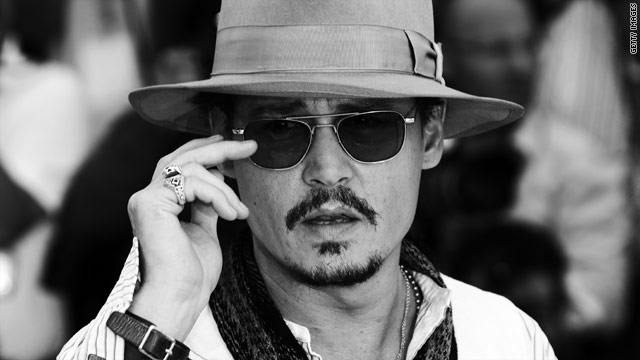




![40 Amazing Nature Wallpapers 1920 X 1200 [Set 7] 40 Amazing Nature Wallpapers 1920 X 1200 [Set 7]](https://blogger.googleusercontent.com/img/b/R29vZ2xl/AVvXsEiQepGmb0NzJQ18L46SAo5bDWPBTBw089PUtJ3BE5QxvudWqDgH3O-bHwvk1G_Swtx38z8pLvEoBcTv6t5nsUbIqnOYK1spgP3e6OMQU1pGtgg7FtPLXCF3EclWip2MmBIpXFzju-pwSSM/s1600/40+Amazing+Nature+Wallpapers+1920+X+1200+%255BSet+7%255D+%2528www.allwallpapersfree.org%2529.jpg)






![80 Stunning Landscapes Wallpapers 1920 X 1200 [Set 7] 80 Stunning Landscapes Wallpapers 1920 X 1200 [Set 7]](https://blogger.googleusercontent.com/img/b/R29vZ2xl/AVvXsEjzUctnANKjS8oxYN3hpbvgoJx7V8tydpXg18wPNsobIPaxDRZS3oZttYy7qwiZ-OHWOHbLSUuCflb-uvm_T63ZP32EtXhZLHJb6nh_X23a5HzC7laG5qjKgamCIZEyopinlCzBilRtaso/s1600/80+Stunning+Landscapes+Wallpapers+1920+X+1200+%255BSet+7%255D+%2528www.allwallpapersfree.org%2529.jpg)
![50 Amazing Nature HD Wallpapers 2560 X 1600 [Set 6] 50 Amazing Nature HD Wallpapers 2560 X 1600 [Set 6]](https://blogger.googleusercontent.com/img/b/R29vZ2xl/AVvXsEhloccis7pJFE6XyOcRO5oMTCUvaVEne2ofZC7oqaRfpGFJT2GNtxcwnFHCOrc0njBgXHKdycjp_Xtd1B2oanME-OeJL86yMEcZvMZ2sEGnxcAv7sVmcYi4YsVgRnivukUAtzCF6hrkX-A/s1600/50+Amazing+Nature+HD+Wallpapers+2560+X+1600+%255BSet+6%255D++%2528www.allwallpapersfree.org%2529.jpg)
![100 Amazing Animals Wallpapers 1600 X 1200 [Set 22] 100 Amazing Animals Wallpapers 1600 X 1200 [Set 22]](https://blogger.googleusercontent.com/img/b/R29vZ2xl/AVvXsEiPSMI_ICMMrVmJNifbxeo8wUsKpyMIVWUDrKzGpDhox4bVf9_CMANj5lJZMhR5KifIQHWfxTs0ofg67I40_j7sEFAWET4oyqgBjY9WH9lIgTXMgrl7rNYeY446HNfblJxv6yIActn4KFo/s1600/100+Amazing+Animals+1600+X+1200+%255BSet+22%255D+%2528www.allwallpapersfree.org%2529.jpg)
